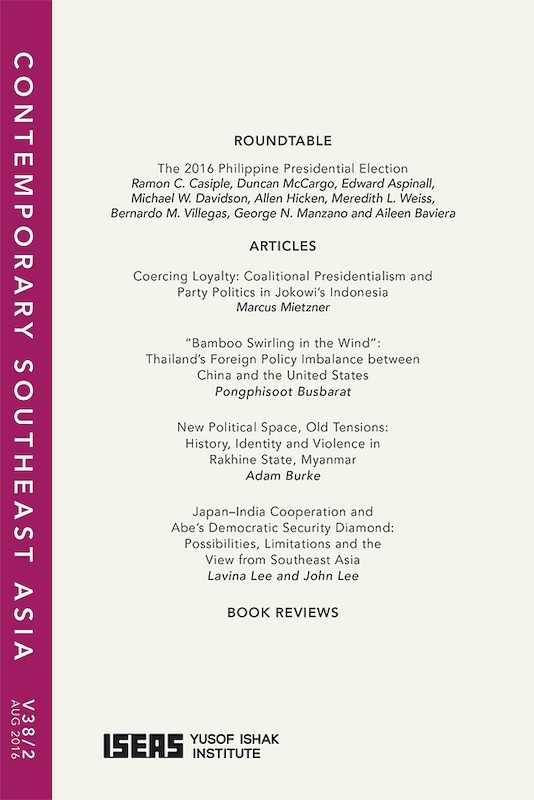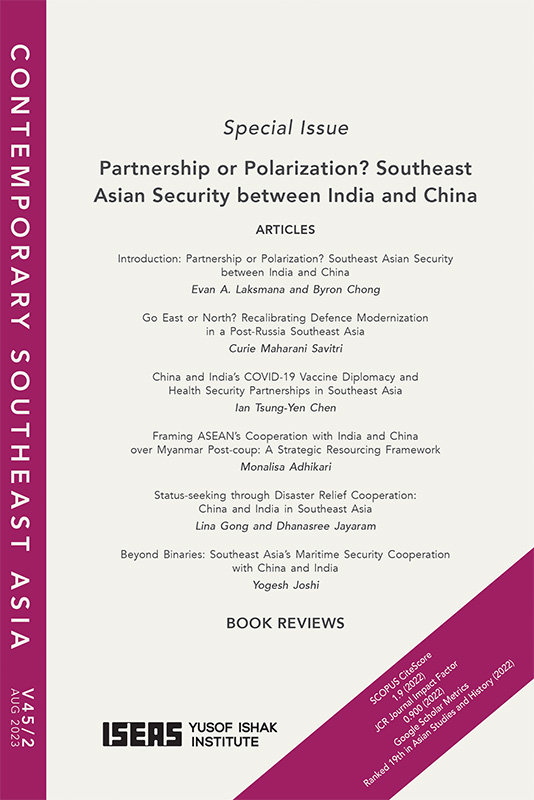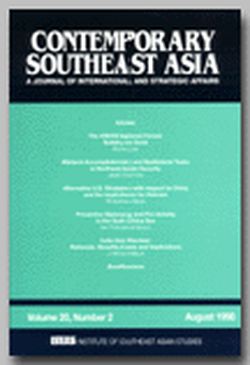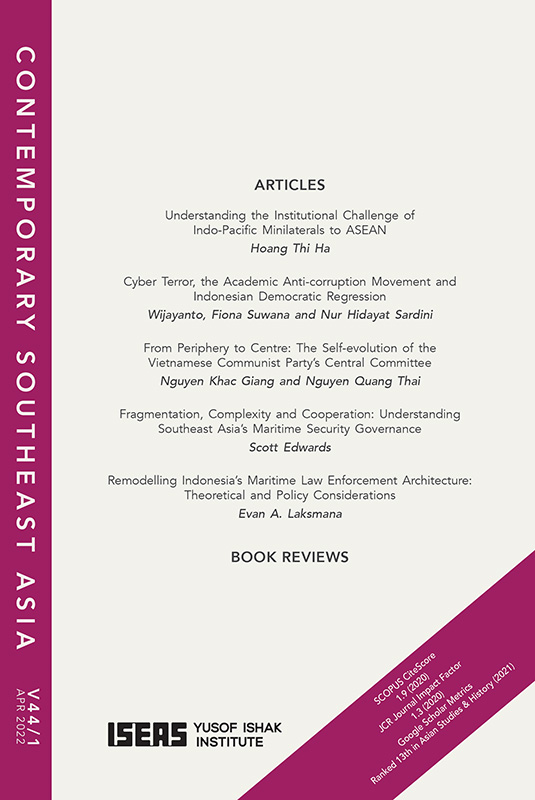Contemporary Southeast Asia Vol. 33/2 (Aug 2011)
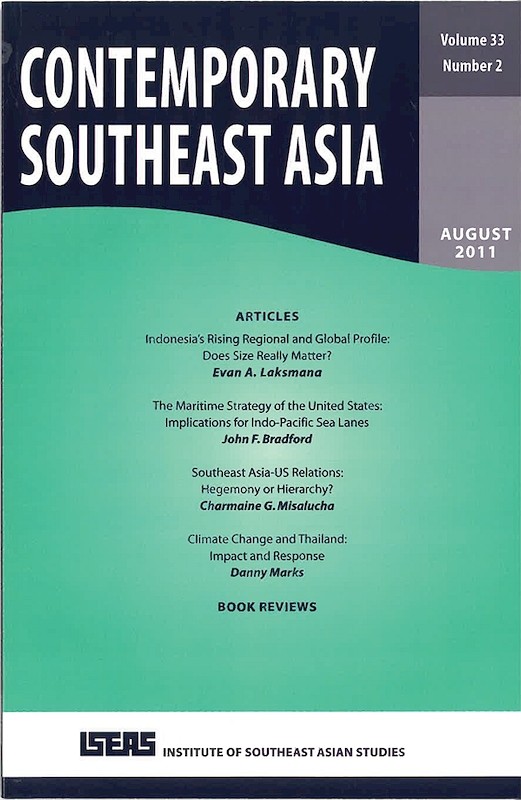
Date of publication:
August 2011
Publisher:
Institute of Southeast Asian Studies
Number of pages:
112
Code:
CS33/2
Contents
-
Contemporary Southeast Asia Vol. 33/2 (Aug 2011)
[Whole Publication] -
Preliminary pages see abstract0
- ARTICLES
-
Indonesia's Rising Regional and Global Profile: Does Size Really Matter?, by Evan A. Laksmana, author see abstractThis paper seeks to challenge the view that Indonesia's geographical and population size account for its rising regional and global profile. Instead, it makes three inter-related arguments. First, the manifestations of Indonesia's foreign policy and global profile have always been based on its ability to harness the country's normative and moral voice. Second, while democratization since 1998 has allowed Indonesia to restore its reputation in world affairs and provided it with a new source of "soft power", it has also complicated foreign policy-making. Third, Indonesia's large geographical size and population have been a source of persistent internal security threats, and because the government has been unable to meet national defence requirements, the growth in its defence diplomacy activities reflect the country's continuing strategic weakness rather than its strength.
-
The Maritime Strategy of the United States: Implications for Indo-Pacific Sea Lanes, by John Bradford, author see abstractThe maintenance of safe and secure sea lanes, particularly those that link the United States with its partners in the Indian and Pacific Oceans, is at the very core of U.S. interests. Therefore, U.S. maritime strategy seeks to sustain credible combat power in the Western Pacific and Arabian Gulf/Indian Ocean so as to preclude attempts at interrupting vital sea lines of communication (SLOCs) and commerce. Given these strategic imperatives and the capability of both state and non-state actors to disrupt the Indo-Pacific sea lanes critical to global prosperity, the United States has renewed its commitment to maritime security in Asia. In recent years, the United States has made significant adjustments to its defence posture in order to bring more maritime forces closer to Indo-Pacific sea lanes and defence officials have stated their intention to further enhance U.S. posture in Southeast Asia and the Indian Ocean while maintaining U.S. presence in Northeast Asia. Recognizing that the expansive nature of Indo-Pacific maritime territory and the complexity of the region's maritime challenges prevent any one country from resourcing the operations necessary to provide sea lane security, the United States is also strengthening cooperation with its maritime partners by expanding relationships and trust-building efforts, contributing to the capacity of its partners and enhancing interoperability. At the same time, the United States is supporting the strengthening of maritime symposiums and regional organizations as the foundations for the security architectures necessary to ensure the security of Indo-Pacific sea lanes and sustain regional prosperity.
-
Southeast Asia-US Relations: Hegemony or Hierarchy?, by Charmaine G. Misalucha, author see abstractIn current International Relations literature, hegemony and hierarchy describe two possible types of international rule. At the theoretical level, their existence makes two presuppositions: first, that they operate independently from each other; and second, that a set of actors experience only one type of rule (that is, hegemony or hierarchy). But what happens when more than one type of rule seems to prevail over the same set of actors? In an attempt to answer this question, this article examines Southeast Asia-U.S. relations in the post-9/11 period and argues that it is possible for international orders to coexist. While the "war on terror" depicted the centrality of the United States, it subsequently became apparent that Washington could only guarantee its place in the hierarchy if it projected itself as a benign hegemon. The article concludes that the existence of multiple types of international rule is a demonstration of the ongoing efforts of states towards building and maintaining deeper relations with each other.
-
Climate Change and Thailand: Impact and Response, by Danny Marks, author see abstractThe impacts of climate change on Thailand - namely prolonged droughts, decreased agricultural and fishery yields, violent flooding, sea level rise and health-related issues - are already serious and will likely create or exacerbate a number of additional problems during the next few decades. These include water management challenges, heightening of class-related tensions, a flood of new immigrants and refugees, damage to the tourism industry and conflict with China over dam-building. While the government has begun framing policies to both adapt to and mitigate climate change, its response so far has been limited due to shortcomings in both the planning and implementation processes. Thailand's ongoing political crisis also diverts decision-maker's attention away from this issue. In the coming decades, Thailand's institutional structure and political economy will hinder its capacity to address climate change and, while these capacities will improve as the country democratizes, it will still be limited. Consequently, climate change will retard the country's growth and enormously strain the country's political system, state and society. Consequently, climate change will retard the country's growth and enormously strain the country's political system, state and society.
- BOOK REVIEWS
-
BOOK REVIEW: Cambodia's Curse: The Modern History of a Troubled Land. By Joel Brinkley, by Sophal Ear, author
-
BOOK REVIEW: Myanmar/Burma: Inside Challenges, Outside Interests. Edited by Lex Rieffel, by David S Mathieson, author
-
BOOK REVIEW: Political Authority and Provincial Identity in Thailand: The Making of Banharn-buri. By Yoshinori Nishizaki, by Björn Dressel, author

